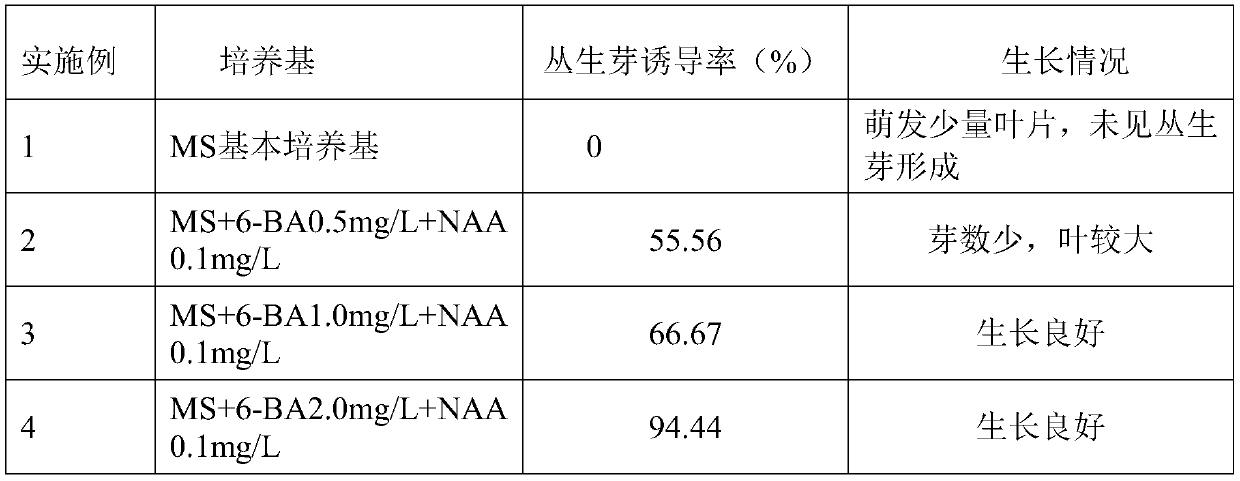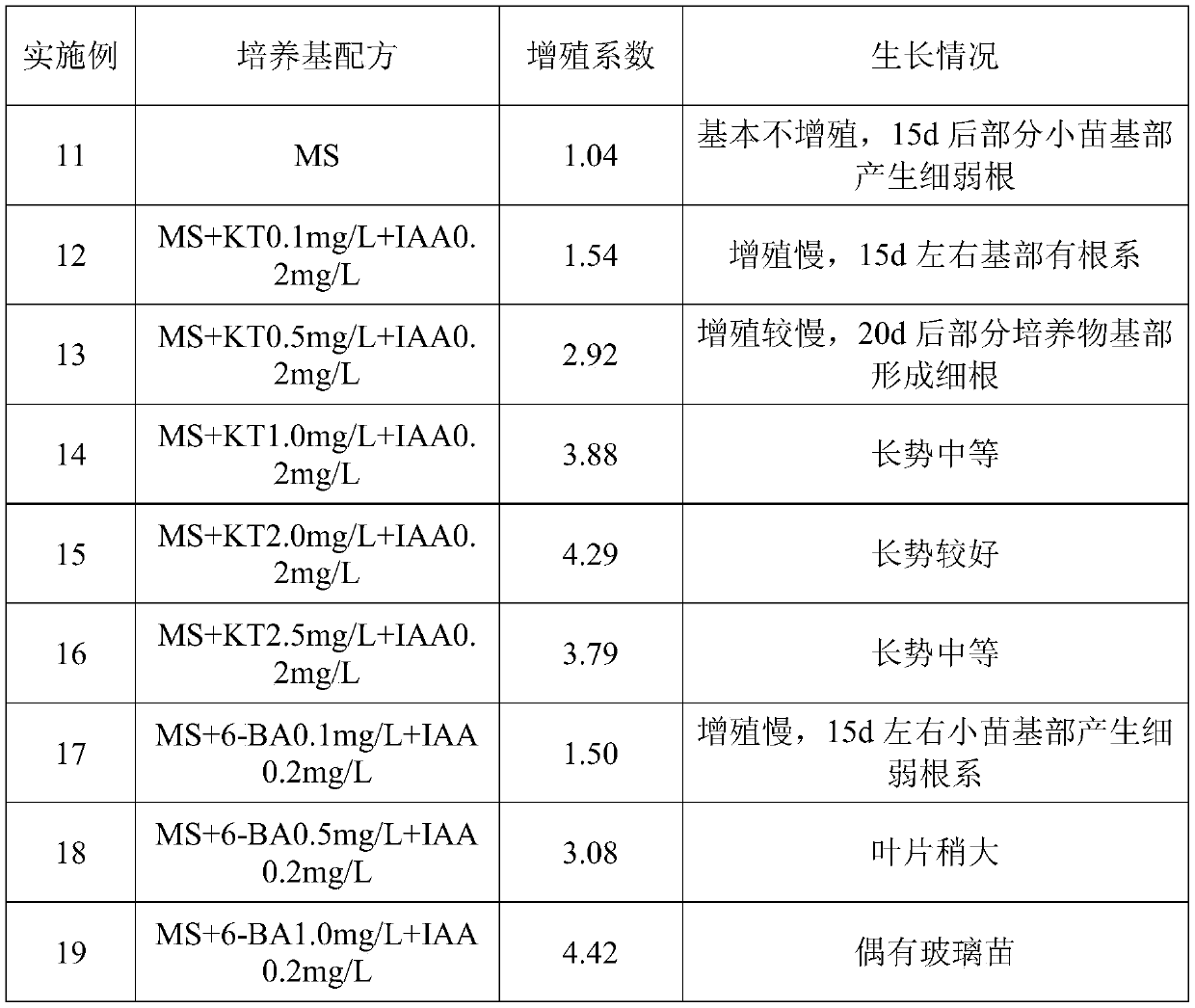A kind of cultivation method of alum root 'matcha' seedling
A cultivation method and technology of alum root, applied in the field of plant cultivation, can solve the problems of long division propagation period, limited supply of seedlings, poor seedling consistency, etc., to reduce the variation of test-tube seedlings, avoid the variation of test-tube seedlings, and increase the propagation speed Effect
- Summary
- Abstract
- Description
- Claims
- Application Information
AI Technical Summary
Problems solved by technology
Method used
Image
Examples
Embodiment 1~9
[0037] Using the stem base tissue of alum root 'Matcha' in spring and summer as explants, the explants are first sterilized. The aseptic treatment is to rinse the explants with running water for 1.5 hours, and then place them on an ultra-clean workbench. Above; soak in ethanol with a mass fraction of 75% for 30-40s; then soak in sodium hypochlorite solution (adding 1-2 drops of Tween) with an available chlorine concentration of 0.4%-0.6% for 10-12min; finally rinse with sterile water for 4 -After 5 times, blot the surface moisture with sterile gauze;
[0038] Next, cut the stem base of the alum root 'Matcha' after the aseptic treatment into 0.8-1.2 cm lengths and inoculate them on the induction medium for clustering buds, inoculate 3 explants in each bottle, and inoculate 6 bottles for each treatment; , the induction medium of clustered buds corresponds to MS basic medium, MS+6-BA0.5mg / L+NAA0.1mg / L, MS+6-BA1.0mg / L+NAA0.1mg / L respectively according to embodiment 1~9 L, MS+6-BA...
Embodiment 10~25
[0049] After clustering buds are divided into single buds, they are respectively inoculated in the proliferation medium for proliferation culture. Each bottle is inoculated with 4 small buds as a treatment, and each treatment is inoculated with 6 bottles. The proliferation culture period is 30 days; Examples 10-25 correspond to MS basic medium, MS+KT0.1mg / L+IAA0.2mg / L, MS+KT0.5mg / L+IAA0.2mg / L, MS+KT1.0mg / L+IAA0.2mg / L, MS+KT2.0mg / L+IAA0.2mg / L, MS+KT2.5mg / L+IAA0.2mg / L, MS+6-BA0.1mg / L+AA0.2mg / L, MS+6 -BA0.5mg / L+IAA0.2mg / L, MS+6-BA1.0mg / L+IAA0.2mg / L, MS+6-BA2.0mg / L+IAA0.2mg / L, MS+6-BA0 .2mg / L+KT0.5mg / L+IAA0.2mg / L, MS+6-BA0.2mg / L+KT1.0mg / L+IAA0.2mg / L, MS+6-BA0.3mg / L+KT0 .5mg / L+IAA0.2mg / L, MS+6-BA0.3mg / L+KT1mg / L+IAA0.2mg / L, MS+6-BA0.5mg / L+KT0.2mg / L+IAA0.2mg / L.
[0050] The test results are shown in Table 2, which shows that:
[0051] (1) In combination with Example 10 in Table 2, the single bud of 'Matcha' hardly proliferates on the MS medium without plant growth regulators. A...
Embodiment 26~38
[0060] After a certain amount of clustered buds were obtained from the multiplication culture, the clustered shoots were divided into individual sprouts, the old leaves at the base were gently pulled off, and they were respectively inoculated in the rooting medium to induce rooting. Each bottle was inoculated with 8 plants, and each treatment was inoculated with 4 bottles. 25 Complete plants were formed after -30d; wherein, the proliferation medium corresponds to 1 / 2MS basic medium, 1 / 2MS+IBA0.2mg / L, 1 / 2MS+IBA0.5mg / L, 1 / 2MS respectively according to Examples 26-38 +IBA1.0mg / L, 1 / 2MS+IBA1.5mg / L, 1 / 2MS+NAA0.1mg / L, 1 / 2MS+NAA0.2mg / L, 1 / 2MS+NAA0.5mg / L, 1 / 2MS +NAA1.0mg / L, 1 / 2MS+IBA0.5mg / L+NAA0.1mg / L, 1 / 2MS+IBA0.5mg / L+NAA0.2mg / L, 1 / 2MS+IBA0.5mg / L+NAA0 .3mg / L, 1 / 2MS+IBA0.5mg / L+NAA0.4mg / L.
[0061] The results are shown in Table 3, showing that:
[0062] (1) In conjunction with Example 26 in Table 3, on the MS medium without plant growth regulators, the alum root 'Matcha' tissue cult...
PUM
 Login to View More
Login to View More Abstract
Description
Claims
Application Information
 Login to View More
Login to View More - R&D
- Intellectual Property
- Life Sciences
- Materials
- Tech Scout
- Unparalleled Data Quality
- Higher Quality Content
- 60% Fewer Hallucinations
Browse by: Latest US Patents, China's latest patents, Technical Efficacy Thesaurus, Application Domain, Technology Topic, Popular Technical Reports.
© 2025 PatSnap. All rights reserved.Legal|Privacy policy|Modern Slavery Act Transparency Statement|Sitemap|About US| Contact US: help@patsnap.com



